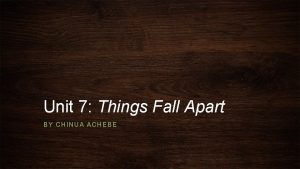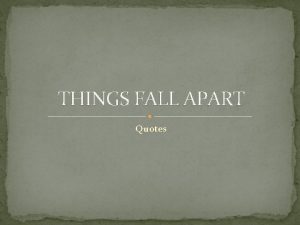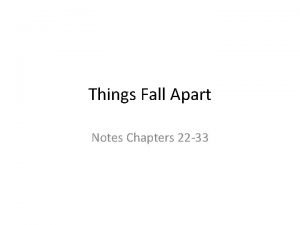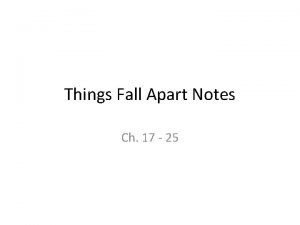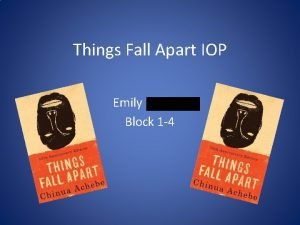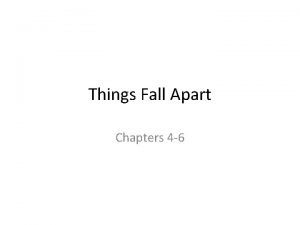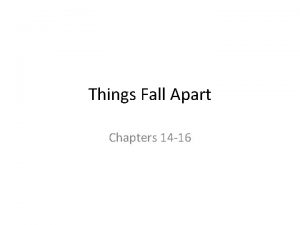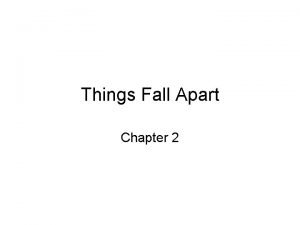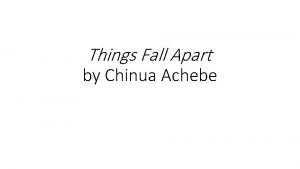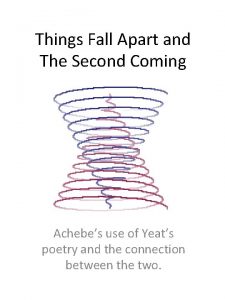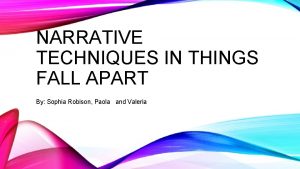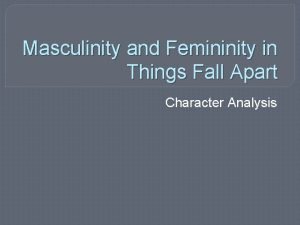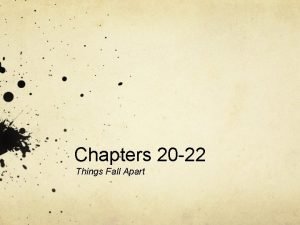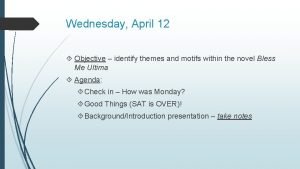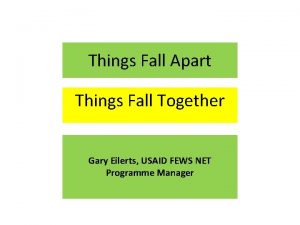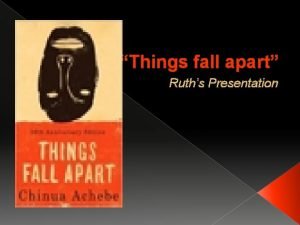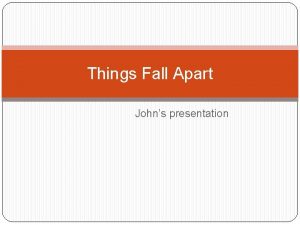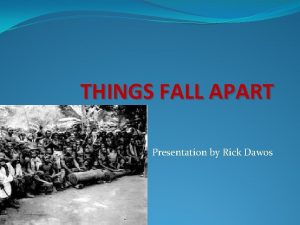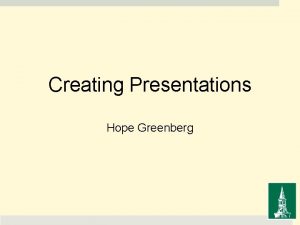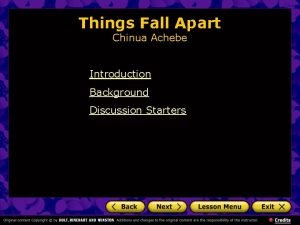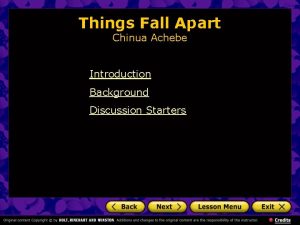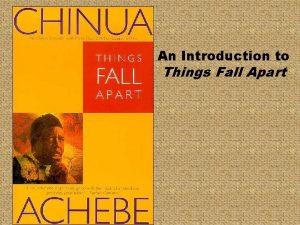Presentations on Things Fall Apart Ms Teref Presentation
























- Slides: 24

Presentations on Things Fall Apart Ms. Teref

Presentation template 1. Essential question 2. Level 1 questions (“right there, ” pronoun antecedent, syntax) 3. Connect to essential question 4. Level 2 questions (diction, imagery, figurative language, tone, selection of detail) 5. Connect to essential question 6. Level 3 (apply to life)

Rules + glance at Ms. Teref’s tips on how to facilitate a whole class discussion 1. TIME YOURSELVES!!! 2. Walk around; switch positions with your partner. 3. Get EVERY student involved. “How many of you…? ” throughout your presentation. 4. Use your sense of humor. 5. Give specific credit to students (Not: “Good job. ” but “I like how Katie pushed back gently on what Colette said but also…”) 6. Leave 2 minutes at the end for the class to provide feedback.

Central question: • Who is busy and who’s idle? (ask questions about the meaning of the words, what it means to be busy vs. idle in our culture)

(optional slide) Nigerian Tribes in pictures You need 1 big and clear picture here; ask questions to relate back to your anthro question

Level 1 Questions: Questions p. 13, last paragraph – 8 min; (Have 3 -5 “right there” questions, 3 -5 pronoun questions, AND 2 syntax questions) “RIGHT THERE QUESTIONS” (3 -5 questions) 1. When did Okonkwo work daily on his farms? 2. What was the evidence of his physical strength? 3. Why did his wives and young children suffer? 4. In Okonkwo’s view, what was Nwoye’s problem? 5. How did Okonkwo “correct” the problem? “PRONOUN QUESTIONS” (3 -5 questions) 6. In line 7, what does “that” refer to, OR what is its antecedent? Relate back to the central question. 7. In line 8, what does “it” refer to, OR what is its antecedent? Relate back to the central question. 8. In lines 8 and 9, who is “he, ” and who is “him”?

Level 1 Questions: Questions p. 13, last paragraph – 8 min - CONTINUATION “SYNTAX QUESTIONS” (3 -4 questions) 1. Identify the first simple sentence with a compound predicate. Rephrase it in your own words AND relate it to your anthro question. 2. Identify the first compound sentence in the passage. Rephrase it in your own words AND relate it to your anthro question. 3. Identify the first independent clause beginning with a FANBOY. What purpose does the conjunction (FANBOY) serve? 4. Examine the last sentence in the paragraph. How do the FANBOYS help us understand this and the previous sentence better? Relate back to your anthro question.

Level 2 Questions: PLEASE ASK only 2 Interpretive Questions – one literary device per question –diction, tone, syntax, figurative language, irony, POV, imagery, epiplexis… 1. DICTION (WORD CHOICE) QUESTION: Find all the words in the passage that imply violence and negative feelings. What is implied by these words? Dig deeper and look for textual evidence. 2. SYNTAX/TONE QUESTION: Identify 2 compound sentences are in this paragraph: What does the equality in rank of these ideas or clauses tell us about the TONE of this passage? 3. IMAGERY: Is there one crisp image in the passage? Relate it to the anthro question.

Level 3 Question: Applied Question (apply to the world, make a real world connection) 5 min 1. How can we understand the Biblical proverb, “Idle hands are the Devil’s playground? ”

My answer to my anthro question: who’s busy and who’s idle? • (One way of approaching this question) Umuofian society has both busy and idle seasons of the year; in fact, this clan has its ancient traditions which require its members to be hard at work during the rainy season and resting during the drought. However, it is during the busy season that the protagonist Okonkwo relives one of the worst fears of his life – the loss of control. • (Another way of approaching the question): Umuofian society has a strict hierarchy whereby every clansman is expected to perform an assigned role in order for the tribe to survive; however, when the protagonist Okonkwo’s father or son is not able to perform these duties, the consequences of such idleness do not only upset the structure of his family but evoke his old fears of survival.

Chapter 4, paragraph 5 From “At first Ikemefuna was very much afraid. ” to “And, indeed, Ikemefuna called him father. ” My question – Question #23: “What are the tacit (unspoken) assumptions and unquestioned practices? ”

Here you need 2 pictures RELEVANT to your topic

Level 3 Question: Applied Question (apply to the world, make a real world connection) 5 min • What are some tacit assumptions or “evident truths” that you encounter every day? How do you feel when you parent/teacher/friend doesn’t have the same tacit assumptions as you or vice versa?

Level 1 Questions: Factual or “Right There” Questions p. 13, last paragraph 1. Identify the first compound sentence. What is its clausal relationship (addition, contrast…)? What are the 2 strong, “adult like” clauses or ideas competing for your attention? 2. What is the first simple sentence with a compound predicate? What 2 facts are we learning about its subject? 3. What is the next simple sentence with a compound predicate? What 2 facts are we learning about its subject? 4. What’s the longest sentence in this paragraph? What is its structure or sentence formula? What are we learning about its subjects in each clause? (pay attention to “child vs. adult” clauses) 5. Identify the only present participle in the longest sentence. What does that “condiment” help us learn about the subject? 6. In the last selected paragraph, observe the 2 sentences with dashes. What is singled out/ set apart/emphasized through the use of dashes? 7. Examine “Okonkwo never showed any emotion…” What’s the main or “adult” idea of this sentence, and what is the subordinate or “child” idea in this sentence? 8. Examine the last sentence in the selected passage. What is the function of the FANBOY and the CONJUNCTIVE ADVERB?

Level 2 Questions: Interpretive Questions • IMAGERY QUESTION: Identify all the sentences which are crisp, vivid images. What do they reveal about Umuofian “tacit assumptions? ” • SYNTAX QUESTION: Identify all of the complex sentences in the selected passage. Who is the subject of the independent clauses, and who is the subject of the dependent clauses? How does this reveal the “tacit assumptions” of the Umuofian society? Whom is this passage really about?

Let’s answer the following anthropological question together: What are the tacit assumptions and unquestioned practices? • (My answer is on the next slide : )

My answer • Evidently, the Umuofian society depends and thrives on its hierarchy at the top of which is the breadwinner or the father. This patriarchal society observes its gender structure unquestionably; namely, the man of the house punishes and rewards while the woman comforts and heals.

Presentation template 1. Essential question 2. Select passage + read it aloud 3. Level 1 questions (“right there, ” pronoun antecedent, syntax) 4. Connect to essential question 5. Level 2 questions (diction, imagery, figurative language, tone, selection of detail) 6. Connect to essential question 7. Level 3 (apply to life)

Step 1: Essential question 1. ESSENTIAL QUESTION: What does it mean to be a man in Umuofia? (talk in groups for 1 min; then report out)

Step 2: Select a passage that matches your essential question + read aloud • Chapter 4, p. 28 • Read aloud

Step 3: Level 1 questions (“right there, ” pronoun antecedent, syntax) • P. 28, same paragraph that I read aloud Right there questions: 1. Who even became fond of the boy? 2. How did Okonkwo feel his fondness for the boy? 3. Who is the boy? 4. Why didn’t Okonkwo show any affection for the boy? 5. What was the only thing that was worth demonstrating for a man? 6. How did he treat Ikemefuna as a result? 7. What is one piece evidence that showed Okonkwo liked the boy and showed it in public? 8. How do we know Ikemefuna loved Okonkwo? Pronoun antecedent questions: 9. In line 3, what is the antecedent for “it? ” 10. In line 5, who is “he? ” 11. In the second to last line, who is “him? ” SYNTAX 12. What is the only one compound sentence in this paragraph? What is the connection between the two SV pairs or clauses?

Step 4: Connect your responses to the essential question: • What does it mean to be a man in Umuofia?

Step 5: Level 2 (diction, imagery, figurative language, tone, selection of detail) 1) DICTION: List all the words that show love or affection? Connect to the essential question. 2) IMAGERY: Identify one sentence that is a vivid, crisp image? Connect to the essential question 3) TONE: Identify 1 sentence that shows the narrator’s tone (some kind of feeling). Connect to the essential question.

Step 6: Level 3 – apply to the real world • In your community, are men allowed to show affection? • Is your community homophobic?
 Egwugwu
Egwugwu Things fall apart context
Things fall apart context Mosquito and ear things fall apart
Mosquito and ear things fall apart Things fall apart chapter 22 summary
Things fall apart chapter 22 summary Things fall apart chapter 20-25 summary
Things fall apart chapter 20-25 summary Flashback in things fall apart
Flashback in things fall apart Good thesis statements for things fall apart
Good thesis statements for things fall apart Things fall apart as a tragedy
Things fall apart as a tragedy Theme of things fall apart
Theme of things fall apart Okonkwo's achievements and status
Okonkwo's achievements and status Things fall apart chapter 4-6
Things fall apart chapter 4-6 Things fall apart chapter 17 summary
Things fall apart chapter 17 summary Things fall apart chapter 14-16 questions and answers
Things fall apart chapter 14-16 questions and answers Okonkwo's compound drawing
Okonkwo's compound drawing Things fall apart epigraph
Things fall apart epigraph Okonkwo compound
Okonkwo compound Ikemefuna personality
Ikemefuna personality Why does nwakibie trust okonkwo to farm his yam seeds?
Why does nwakibie trust okonkwo to farm his yam seeds? Second coming
Second coming Things fall apart pov
Things fall apart pov Father son relationship in things fall apart
Father son relationship in things fall apart Summary of things fall apart chapter 20
Summary of things fall apart chapter 20 Motifs in bless me ultima
Motifs in bless me ultima What is the point of uchendu’s lecture to okonkwo?
What is the point of uchendu’s lecture to okonkwo? Things fall apart chapter 3
Things fall apart chapter 3
